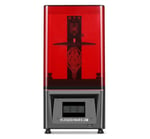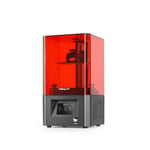Go green. Elegoo comes forth with another iteration of its showrunner, yet it feels like it was only yesterday we were singing the praises of the Elegoo Mars. Its wallet-friendly price, superb printing performance, and all-around ease of use made it a winner in our eyes. A couple of years have now passed, and our fondness for it endures to this day. Afterward came the Mars Pro. Then the Mars 2 Pro (not forgetting the elusive Mars C) and now – illogically – the Mars 2, a cheaper, more accessible version of the Mars 2 Pro.
You can spot the biggest difference between the Mars 2 and past Marsians a mile away; it comes with a green acrylic hood. But with the budget resin printing space becoming as crowded with stars as the Milky Way, can the Mars 2 follow in the footsteps of its highly successful forebears.
We sent out a research team to make first contact. Let’s find out if the Mars 2 is habitable. (Are these space puns doing it for you?)
Verdict

Pros
- Slick design
- Excellent performance
- Seamless operation
Cons
- Vat misses convenience features
- No Wi-Fi
Elegoo cemented itself as one of the top dogs in budget resin 3D printing with numerous iterations of its excellent first effort, the Elegoo Mars. In the Mars 2, we get a refreshing update on this no-frills formula that keeps Elegoo’s main, budget-minded printer as the workhorse we’ve always liked.
Churning out high-detail prints reliably, we like the machine but find ourselves missing some of the convenience features we find on other, similar-priced machines.
At the time of writing, the Mars 2 will set you back ~$230 – considerably less than the Mars 2 Pro. It sits shoulder-to-shoulder with the likes of the Anycubic Photon Mono and Creality LD-002H. We’ve reviewed them all, and all are, essentially, capable of much and the same. If green is your favorite color though, the Mars 2 is probably the printer for you.

The Tech
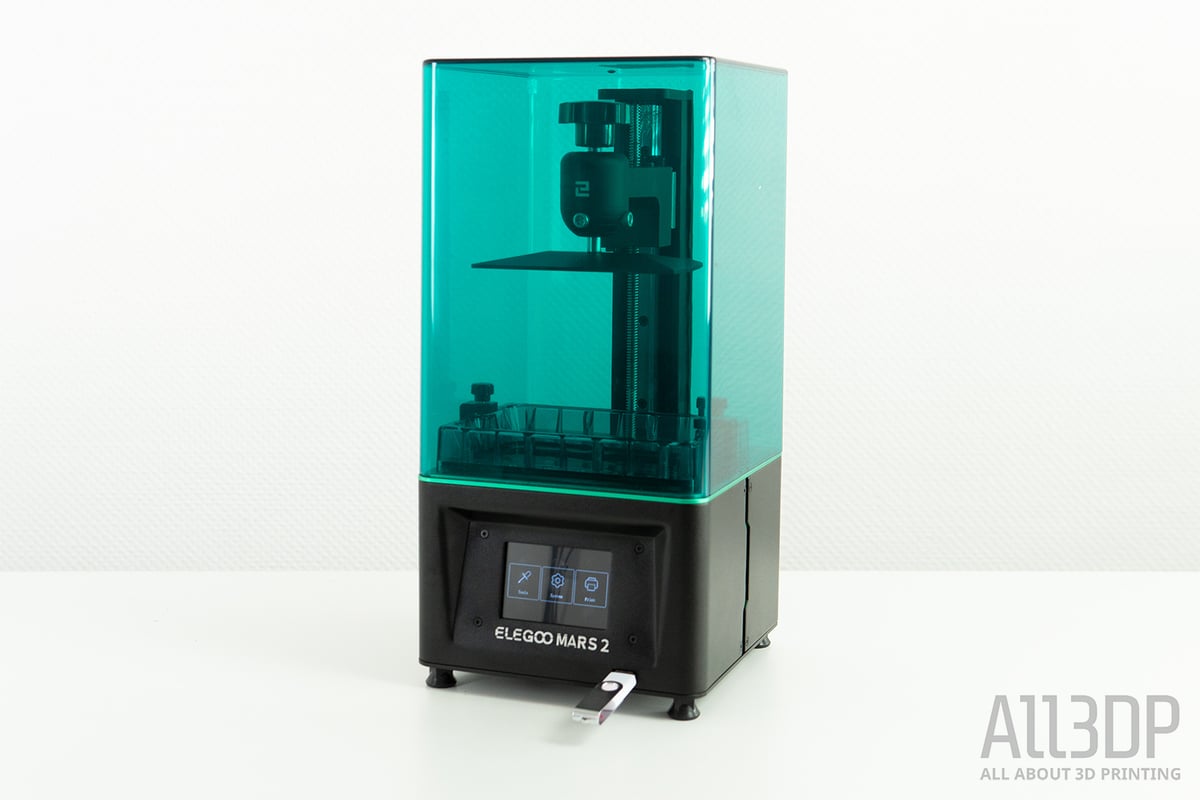
It seems only right for Elegoo to come back to the Mars 2 after jumping from the Mars Pro directly to the Mars 2 Pro. (Or does it?) We’ve lost track.
In any case, the Mars 2 serves as a middle ground between the older machines’ affordability and the fast-printing capabilities of the latest mono-LCD toting “Pro” version. Let’s see what that cooks up to.
Mono
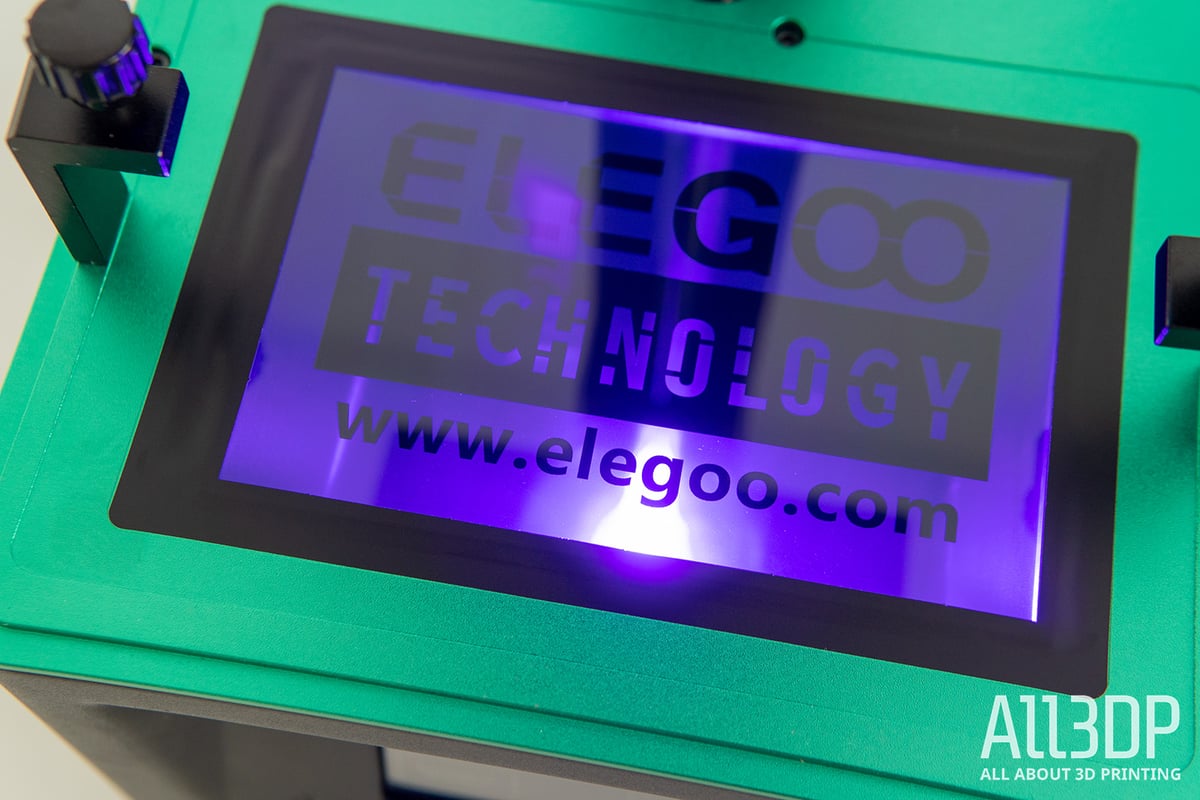
If you have dabbled in resin printing recently, you will quite probably be familiar with the benefits of a monochrome LCD: fast printing. These black-and-white-sounding panels allow for more light to pass through than their RGB contemporaries (such as the panel found in the original Elegoo Mars), resulting in faster layer cure times. To give you some idea of how much faster they are, curing times got expedited from 7-8 seconds per layer to 2-3 seconds. In other words, it’s quite a bit quicker.
It also results in a longer LCD lifespan, meaning you won’t need to shell out as often for a new one. Potentially, your mono LCD will last you four times as long as an RGB equivalent and Elegoo is currently selling replacement screens for $49.
Resolution
The other big leap, or should we say sizeable increase is a switch from a 5.8-inch masking LCD, as used on the original Mars and Mars Pro, to a larger 6.08-inch LCD. Paired with the larger print plate, you get about 10 mm more space on both the X- and Y-axis over the Mars and Mars Pro, totaling out to a total print volume of 129 x 80 x 150 mm. You get 10 mm less in the Z-axis than on the Mars 2 Pro, mind, but overall, a possibility of larger (if not taller) prints than on earlier Elegoo machines.
Resolution
What’s all that size-talk got to do with resolution? Well, the screen’s resolution, and respectively the printer’s granularity, is dictated by the screen’s size and the number of pixels it houses. In the Mars 2’s case you get a 2K 2540 x 1620 pixel-sized panel, which equates out to a pixel size of 50 microns, a standard resolution for this class of budget resin printer that helps keep the Mars 2 competitive with its peers.
Not astonishing numbers, but there are odd cases here and there that push this, such as the Phrozen Sonic Mini 4K. In general, the Mars 2 prints as fine as most other printers in its price class. We’re not seeing a reinvention of the wheel here, but with it being just the Mars 2, the reality is that this is a safe upgrade on the original Mars. Faster printing tech, but not much else.
Go Green
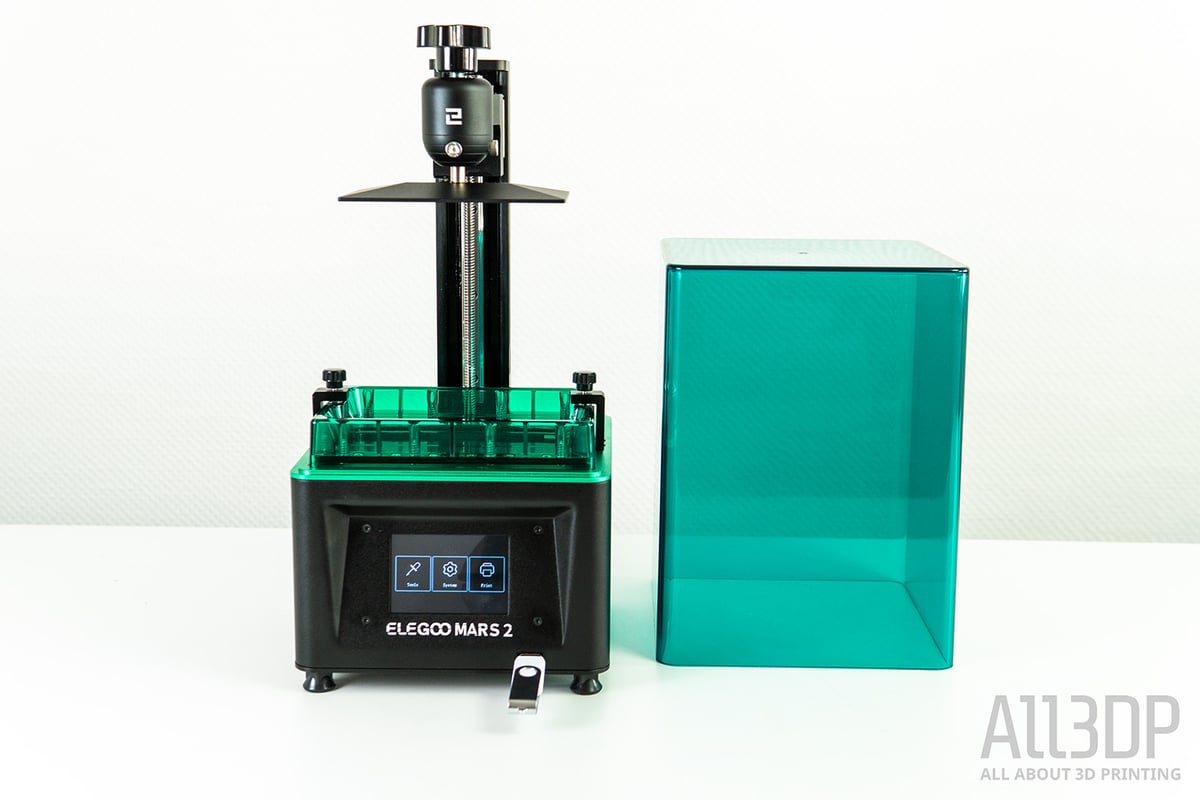
Elegoo didn’t go all out in terms of new technology for the Mars 2, but it sure did when it comes to the color selection. Elegoo first released a green Mars with its limited-edition MyMiniFactory flavor back in 2019, sporting a fetching green UV lid.
We never saw red when looking at the other Mars, but we sure like this new direction.
A purely cosmetic change, this new color scheme shouldn’t have an impact on the actual printing performance and therefore shouldn’t be the sole reason to buy one. Then again, we haven’t even talked about the green vat.
The Vat
If you thought the lid looked cool, check out the green clear-craze vat Elegoo went for on the Mars 2. If that doesn’t give you straight-up 90’s flashbacks, you didn’t live to see them.

Going for a plastic composite vat instead of a metal one, we suspect, mostly comes down to cost. Elegoo isn’t the first to turn to a plastic vat like this, and we doubt they’ll be the last. Some users passionately believe that metal vats are better long-term solution, reasoning that they’re less prone to corrosion from the volatile resin they are holding. Having tested dozens of resin printers over considerable lengths of time, we’ve yet to experience anything that corroborates this, so for the time being, flashy green resin vats get a thumbs up from us.
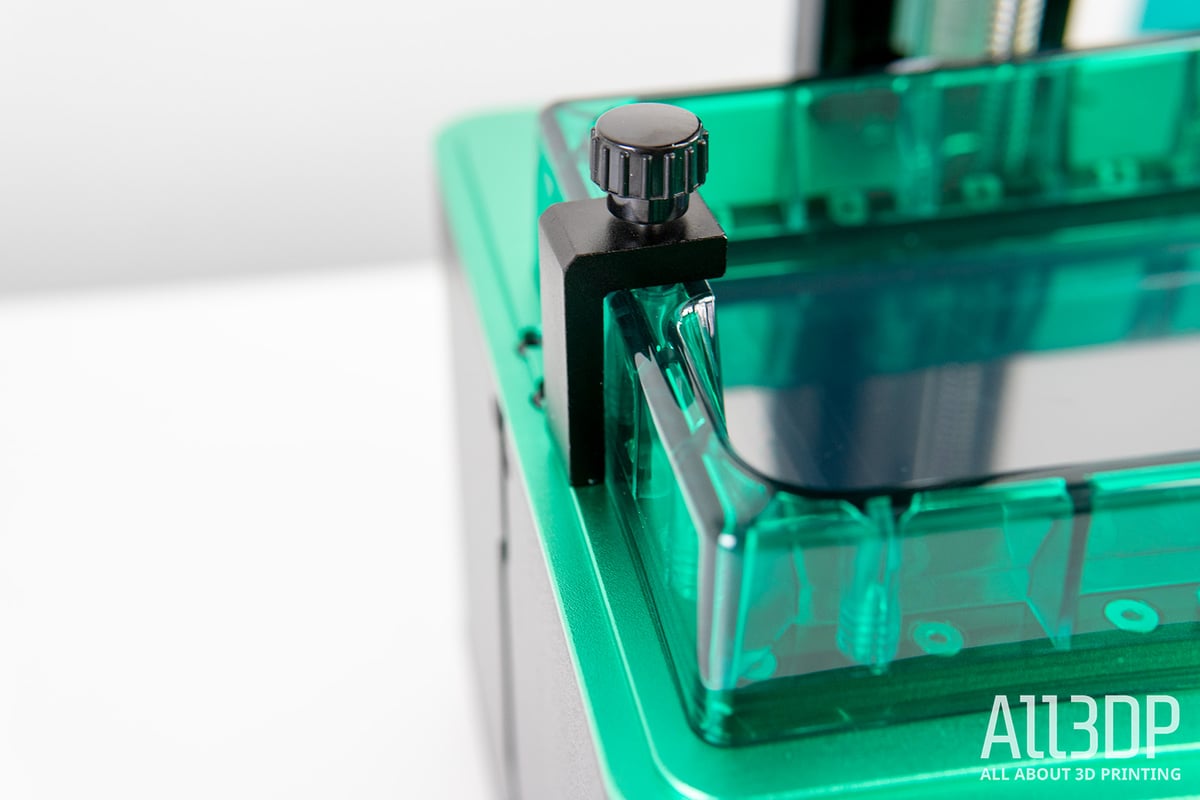
Plastic or not, the vat could still be better. We found ourselves wishing it had a pouring aid, as commonly found molded into the corners of resin vats, and some stilts on the base to keep the vat’s film from picking up desktop debris would also have improved the Mars 2.
Perhaps the aim was to stay as close to the original Mars as possible, without changing too much. But times have changed, and handling these inexpensive, but useful, features are the tiebreakers for many.
With that said, the vat is the slickest looking vat we’ve seen, if that counts for anything.
Mars 2 Pro Differences

Following things chronologically, the Mars Pro was a slightly beefed-up version of the original Mars. However, the Mars 2 is a slightly slimmed-down version of the Mars 2 Pro. We already touched on the fact that the Mars 2 is capable of much and the same as the Mars 2 Pro in terms of printing resolution and capabilities, so what are the real differences here?
Besides the slick green lid and vat, it comes down to one feature: ventilation. The Mars 2 Pro features a built-in activated carbon filter that should capture some of the smell given off by the exposed resin. The Mars 2 doesn’t.
Obviously, having a filtration system is better than not having one. Resin puts out nasty and potentially harmful fumes, which is why we would recommend using any resin printer in a well-ventilated area, filtration or not. If filters such as the one featured on the Mars 2 Pro really do make a difference (we suspect they don’t) shouldn’t all printers have them?
The Rest
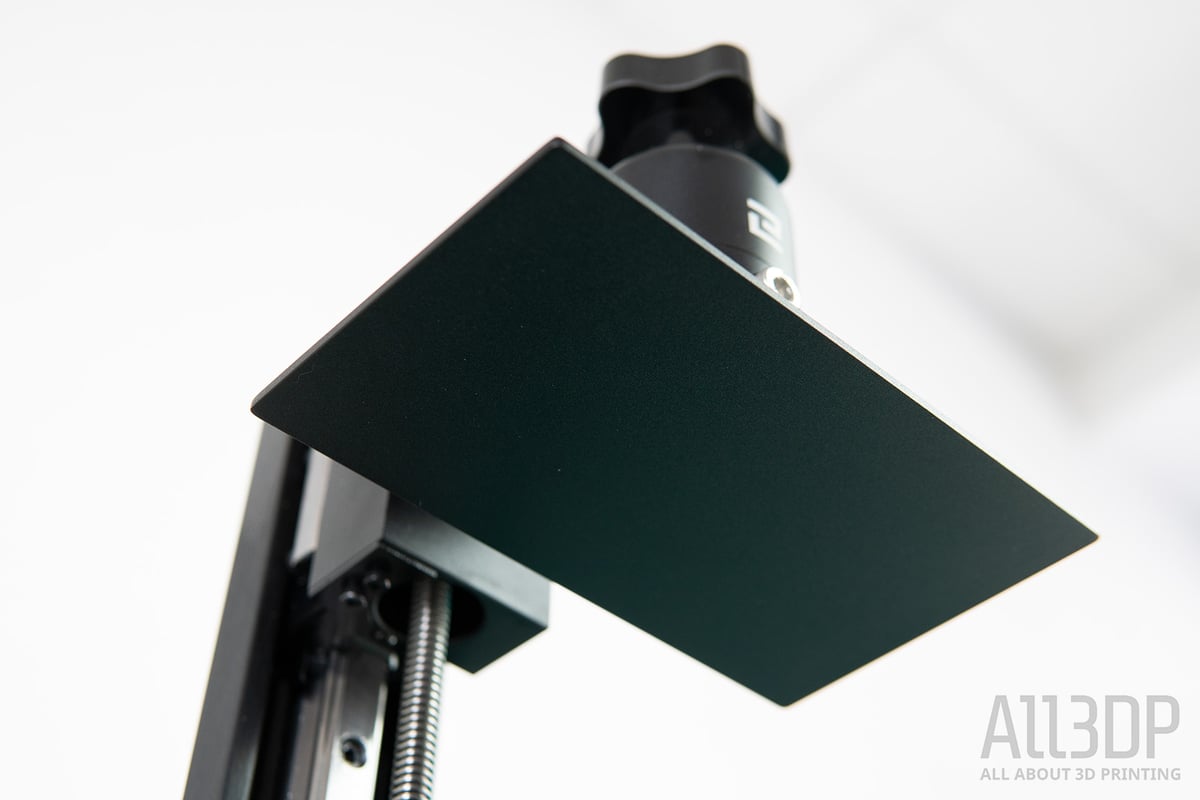
The rest of the Mars 2 is pretty straightforward. The print plate also got a change in color; it now has a coarse black surface instead of silver. Like the vat discussion, we have – after reviewing countless different resin printers and their print plates – yet to find conclusive arguments to rate one over the other.
The power button is sub-optimally located on the back of the printer, but the USB slot is usefully located at the front at least. With USB still being the only connectivity option, one could raise the question about convenience features such as Wi-Fi connectivity and remote control, but given the asking price of – at the time of writing – $230, that would be a question the more expensive Mars 2 Pro should have to answer.

Printing and Usability
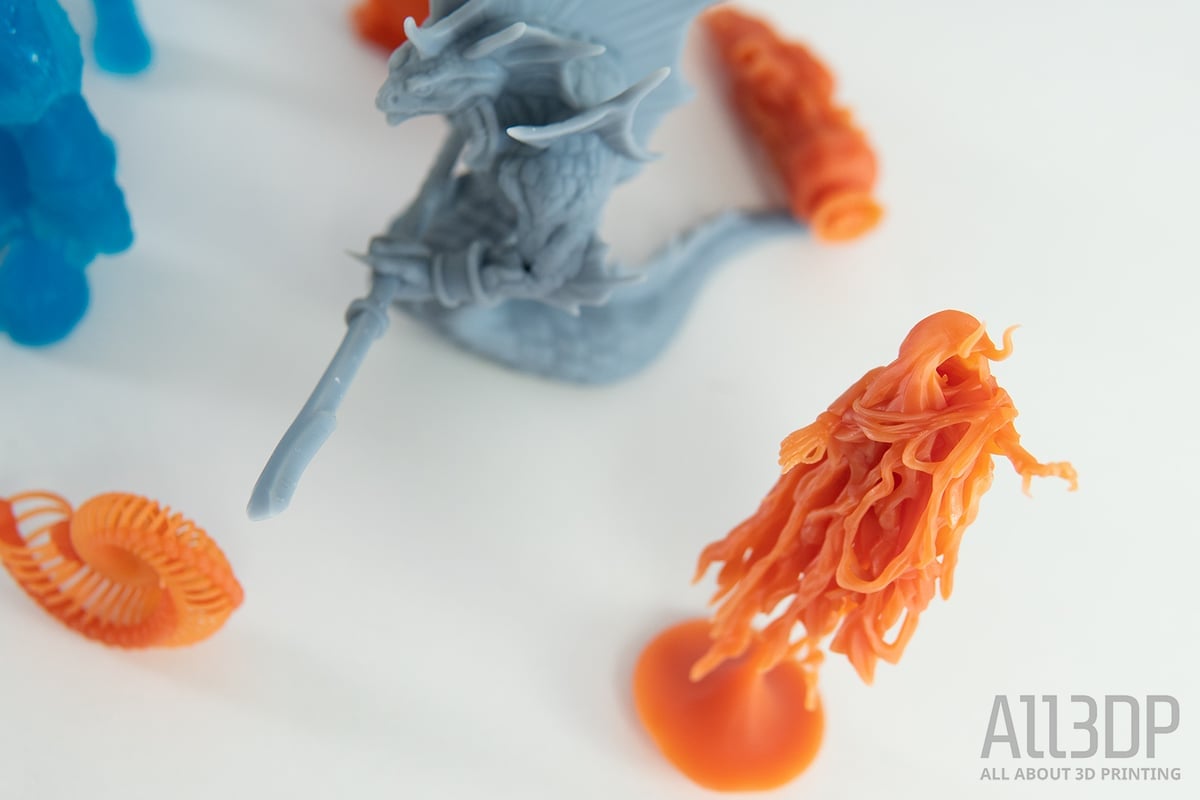
Now that we know all about its built-in hardware, it is time to power up the engines and set a course for Mars.
Before we begin, you should know that printing accuracy and efficiency on the Mars 2 will be pretty much the same as on any other 2K monochrome budget resin printer. One could even go a step further and claim the handling of these printers to be almost identical. In other words, personal taste might tip the scale when choosing a resin printer for yourself.
Setup
Setting up a resin 3D printer usually does not take more than a couple of minutes. The printer comes fully assembled and needs but one final step to be ready to launch, which is leveling the print plate. In this final step, you need to loosen the four screws on the print plate, home it onto a sheet of paper on the screen, recalibrate the Z-axis by tapping a button, fasten the very same screws, and you are good to go. It’s a task even first-timers can do without fuss.
If it wasn’t for the factory-leveled print plate on the Nova Bene4 Mono we recently reviewed, we wouldn’t have found any fault with this easy but tedious setup. We still don’t, but we would hope that more manufacturers take a leaf out of Nova’s book in the future.
Usability

Like most budget resin printers, the Mars 2 uses ChiTu technology at its heart – the heart being, in this case, the mainboard. As such, the ChiTuBox slicer might logically be your go-to software. ChiTuBox is uncomplicated and powerful, providing the user with plenty of tools for successful resin 3D printing. It has impressed us in the past, working well in reviews of the older Mars printers, but there is also a profile available for the Lychee slicer, an equally powerful resin slicer that performs just as well as ChiTuBox.
You can start with a test print from the included USB stick, or have a crack at your preferred slicer right away. Although mono resin printers typically boast curing times as low as 1 second per layer, we found the (Chitu profile) default 2.5 seconds, or even rounded up three seconds per layer, to be the most promising. If you use multiple resins, you might have to play around with the settings in order to obtain the best and/or fastest results with different mixtures.
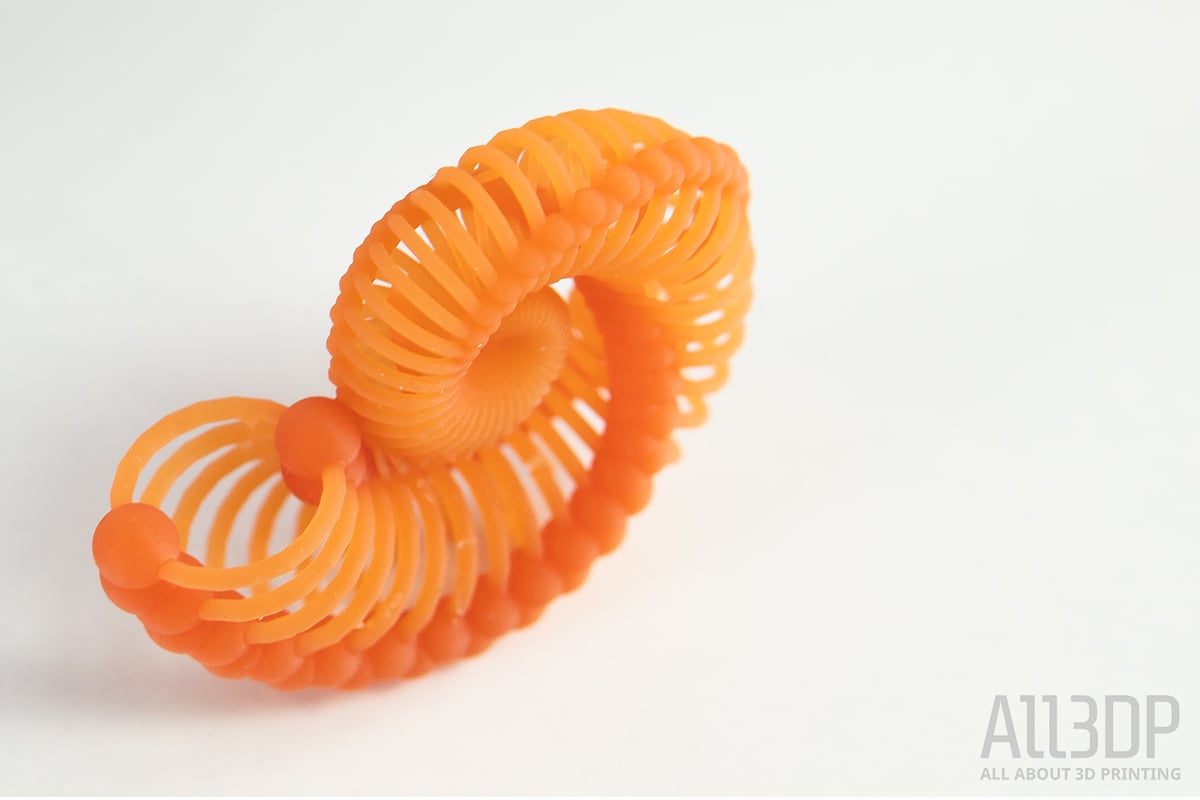
The divergence in duration is negligible, as lifting and lowering the print plate between each layer makes up about nine-tenths of the overall print time. Please note that the estimated time for a print by the slicer is often slightly off the actual time needed when altering any slicer settings. This is not a Mars 2/ChituBox specific problem, but occurs across all slicing platforms and should be taken into account if you are printing with time constraints. For your day-to-day prints, this should have little effect on you.
The printer can be accessed via the 4.3-inch touchscreen and runs on the latest Chitu firmware with a slightly reskinned user interface. It doesn’t really offer any new functions, but the change in layout makes it even more accessible and easy to operate.
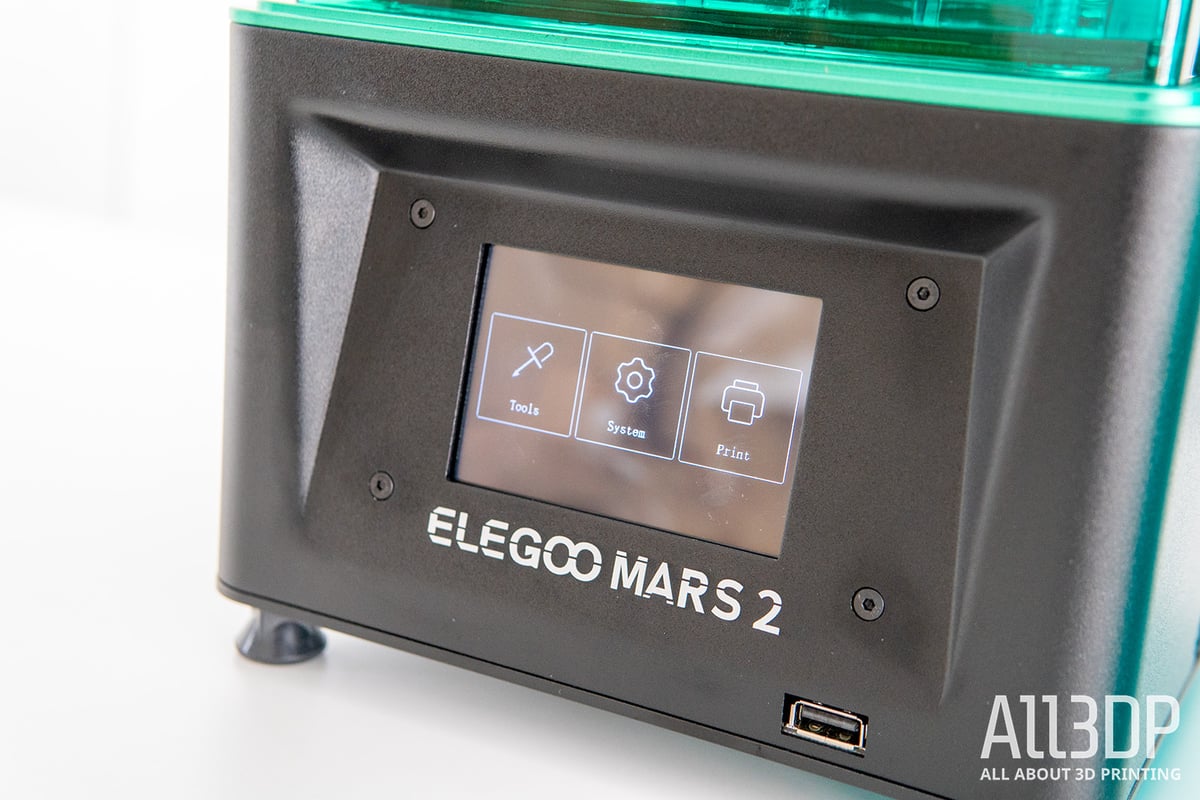
Once set up you should have a smooth ride. Reviewing the Mars 2, we found it to be as fast as you would expect from a monochrome resin printer and as detailed as you want from a 2K high-resolution screen. We said it before and we’ll say it again: For resin printers, this is pretty much the nature of the activity. Expect prints to be produced reliably and effortlessly over and over again.
We do like the Mars 2 for its print quality and seamless ease of use. This is the common theme across the whole Mars series, but not a standalone feature – the same applies to a bunch of competitors out there.

Is It Worth It?
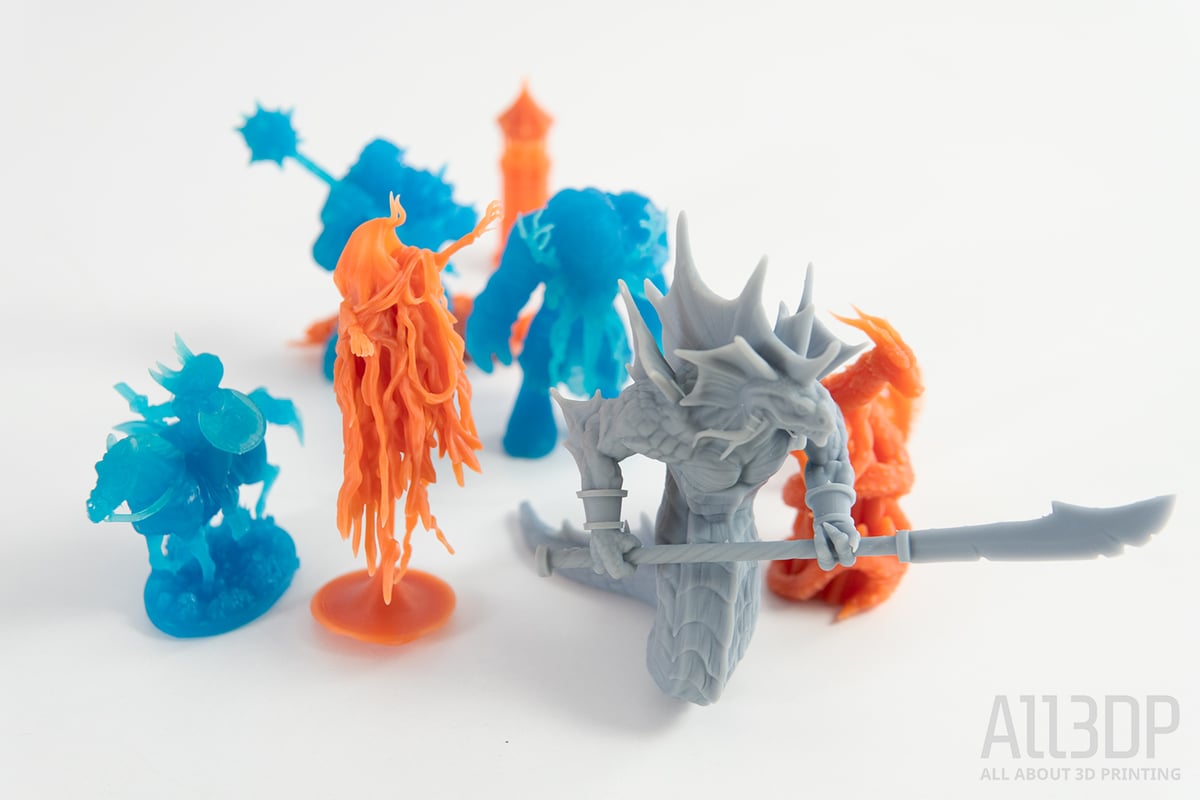
At the time of writing, the Mars 2 will set you back ~$230, which is considerably less than the Mars 2 Pro. But, with more and more budget resin printers making an appearance, the harder it becomes to separate the wheat from the chaff. Not taking the slick-looking vat and lid into account, the Mars 2 really has very little groundbreaking and exciting stuff to offer that makes it stand out from the sea of how-low-can-you-go budget resin printers currently available. Particularly now, that more features formerly considered to be reserved for higher-priced machines, such as Wi-Fi connectivity or a pre-leveled bed, have arrived in the budget sector.
Don’t get us wrong, the Mars 2 is in no way an outdated machine, and it does exactly what it is designed for and told to do in that it prints highly detailed objects quickly and reliably. It seems to be somewhat of an Elegoo tradition to release highly-likable printers that, even upon release, just fall short in relation to rivals when it comes to ease-of-use features. However, people seldomly seem to care. The Mars series has proven itself to be a reliable workhorse, and the Mars 2 does the same – repeatedly.

Features

Here is a run down of the Mars 2’s features.
Monochrome Screen
A fast-curing monochrome screen is the bread and butter of budget resin printers nowadays. You probably know the drill –monochrome screens shrink layer cure times by a factor of four compared to what non-mono screens used to take. Better still, those mono-screens have some four times the lifespan, too. (Over 2000 hours).
All in all, this tech translates to higher printing efficiency and less maintenance. What more could you want?
The Mars 2 features a mono-screen as well as an improved light source over that found on the older, non-mono Mars machines, meaning you can expect the lights on for as little as 1-2 seconds per layer.
Resolution and Build Volume
Fast printing is one thing. Resolution is another. The Mars 2 doesn’t drop its guard here. Like the Mars 2 Pro, it’s housing a 2k (1620 x 2560 pixel) 6.08-inch LCD, providing a printable area of 129 x 80 mm. Resolution-wise, this means an XY-accuracy of 50 microns, pretty much the same you get across all budget LCD resin printers currently on the market. There are exceptions, such as the Phrozen Sonic Mini 4K. but the Mars 2’s numbers are no surprise.
The overall build volume is 129 x 80 x 150 mm – 10 mm less in the Z-axis than on the Mars 2 Pro, but overall it’s larger than earlier Elegoo machines.
Resin Vat
The resin vat used in the Mars 2 takes its cues from the intentionally cheap Mars C, which swaps a lot of metal for plastic in its construction. We’ve seen similar vats before and find them as usable as their metal counterparts. On paper, you could consider it a downgrade. But in practice, the difference is immaterial.
We’re big fans of the slick green color, though – serious clear craze vibes there.
ChituBox Slicer
The Mars 2 uses the ChiTuBox slicer as standard but is supported by others, such as the Lychee slicer. Uncomplicated and powerful, ChiTuBox provides the user with plenty of tools for successful resin 3D printing and has impressed us in the past, working well in reviews of the older Mars printers.
Mars 2 Pro Difference
One final thing to note about the Mars 2 is that it lacks the activated carbon air filter found on Elegoo’s “Pro” Mars printers. This seems to be the main difference that the company uses to draw a line between its basic machines and the pricier units. Even if it did have a filter, we’d still recommend printing in a well-ventilated room. If such filters really did make a difference, we’d expect to see every resin 3D printer have them.

Tech Specs
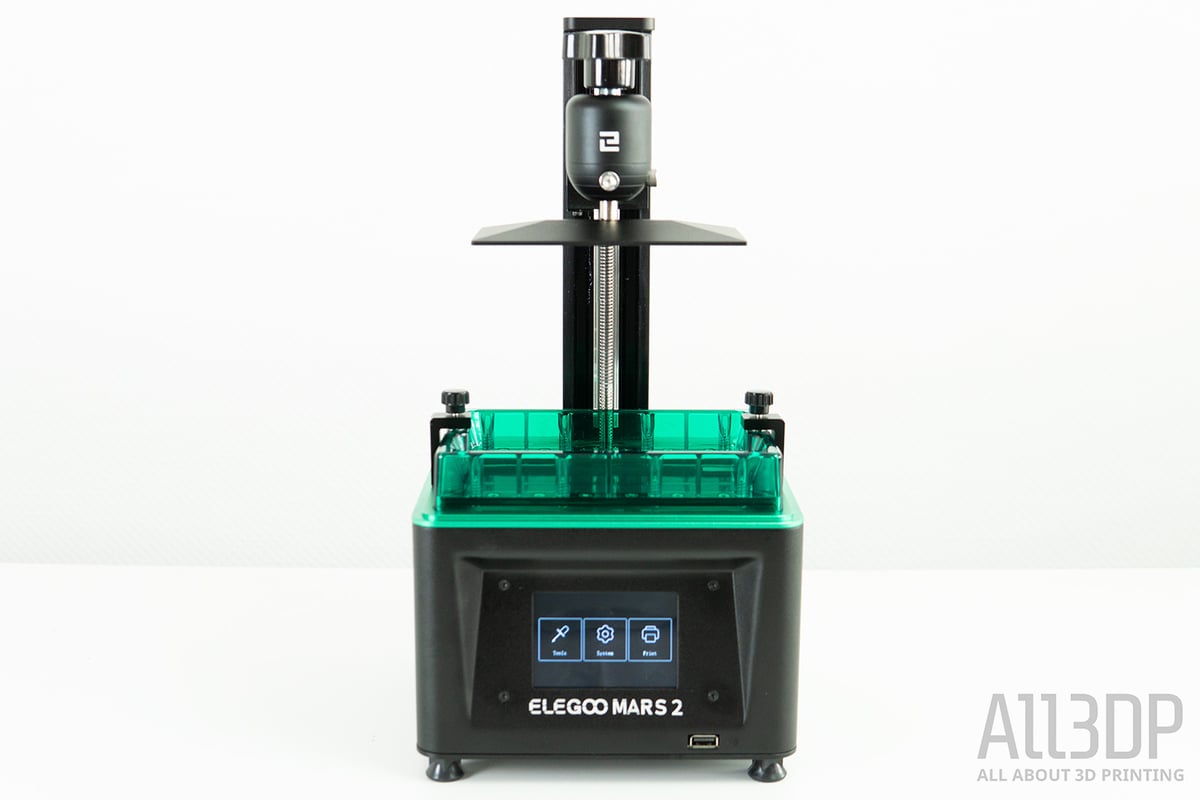
GENERAL SPECIFICATIONS
- Technology: LCD
- Type: Resin
- Year: 2021
- Assembly: Fully-assembled
- Manufacturer: Elegoo
- Country: China
3D PRINTING SPECIFICATIONS
- Build Volume: 129 x 80 x 150 mm
- Layer Height: 10+ microns
- XY Resolution: 50 microns (1620 x 2560 pixels)
- Z-axis positioning accuracy: 0.001 mm
- Printing Speed: 30-50 mm/h
- Bed-Leveling: Semi-automatic
- Display: 3.5-inch touchscreen
- Third-Party Materials: Yes
- Materials: 405 nm UV resin
SOFTWARE REQUIREMENTS
- Recommended Slicer: ChiTuBox
- Operating system: Windows / macOS X
- File types: STL
- Connectivity: USB
DIMENSIONS AND WEIGHT
- Frame dimensions: 200 x 200 x 410 mm
- Weight: ~6.2 kg
- Boxed size: 550 x 340 x 280 mm
- Weight (packed): ~7.5 kg

Similar Printers
You may also be interested in the following printers:
For further information, feel free to check out our Best Resin Printers Guide.
Anycubic Photon Mono
The Anycubic Photon Mono is another budget resin printer that features almost identical specs in terms of resolution and printing speed but offers an overall larger build volume due to its 165 mm tall Z-axis. Another budget workhorse, sure to do its tasks dutifully.
Elegoo Mars 2 Pro
It’s a bit of a no-brainer that the Elegoo Mars 2 Pro is similar to the Mars 2. Featuring the same monochrome screen and lightning-fast layer curing times, the Mars 2 Pro edges the plain Mars 2 with 10 mm extra Z height, as well as “Pro” features such as an activated carbon filter and metal vat. We’re not sure those are enough to justify the jump in price.
Creality LD002-H
Creality’s 2nd generation resin 3D printer, the LD-002H, offers an identical build plate but a slightly larger Z-axis height of 160 mm. It also features an inbuilt air filtration unit countering those pesky resin smells.
License: The text of "Elegoo Mars 2 Review: Budget Pick" by All3DP is licensed under a Creative Commons Attribution 4.0 International License.
CERTAIN CONTENT THAT APPEARS ON THIS SITE COMES FROM AMAZON. THIS CONTENT IS PROVIDED ‘AS IS’ AND IS SUBJECT TO CHANGE OR REMOVAL AT ANY TIME.






